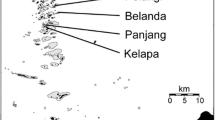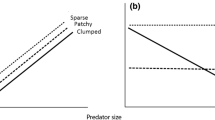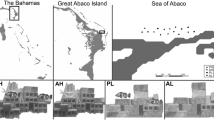Abstract
Complex habitats serve as a refuge by impeding predator movement and the detection and capture of prey. The attributes that make up these habitats often covary and are difficult to evaluate. The purpose of our study was to understand how attributes of habitat structure contribute to the survival of a temperate rocky reef fish, the bluebanded goby, Lythrypnus dalli. We first used natural substrata (rock) and then artificial standardized habitat units (SHUs) to explore attributes that likely reduce predation of L. dalli. Survival was positively related to the size of rock, but multiple attributes covaried, including rugosity, interstitial space between rocks, total surface area, rock height, and the number of rocks per plot. Using SHUs, we manipulated gap distance (to limit predator access) and potential refuge volume (interstitial space) orthogonally between artificial ‘rocks’ while controlling other habitat attributes. Degree of predator access (PA) was more influential on survival of individuals when combined with low interstitial space (IS) than high, but a combination of low IS and low PA was necessary for consistently high survival. We also conducted a behavioral laboratory experiment to ascertain whether the distribution of L. dalli among configurations of habitat differed in the presence and absence of an important predator, the kelp bass, Paralabrax clathratus. Individuals selected habitat configurations with low spacing between structures, consistent with survival patterns observed in the field. Our study indicates that habitat attributes vary in their importance to survival, but their combined effects may be greater than those of any single attribute.





Similar content being viewed by others
References
Aguirre JD, McNaught DC (2011) Habitat modification affects recruitment of abalone in Central New Zealand. Mar Biol 158:505–513
Allen LG, Bouvier LS, Jensen RE (1992) Abundance, diversity, and seasonality of cryptic fishes and their contribution to a temperate reef fish assemblage off Santa Catalina Island, California. Bull South Calif Acad Sci 91:55–69
Almany GA (2004) Differential effects of habitat complexity, predators and competitors on abundance of juvenile and adult coral reef fishes. Oecologia 141:105–113
Alvarez-Filip L, Dulvy NK, Gill JA, Cote IM, Watkinson AR (2009) Flattening of Caribbean coral reefs: region-wide declines in architectural complexity. P Roy Soc B-Biol Sci 276:3019–3025
Anderson TW (2001) Predator responses, prey refuges, and density-dependent mortality of a marine fish. Ecology 82:245–257
Bartholomew A (2002a) Faunal colonization of artificial seagrass plots: the importance of surface area versus space size relative to body size. Estuaries 25:1045–1052
Bartholomew A (2002b) Total cover and cover quality: predicted and actual effects on a predator’s foraging success. Mar Ecol Prog Ser 227:1–9
Bartholomew A, Diaz RJ, Cicchetti G (2000) New dimensionless indices of structural habitat complexity: predicted and actual effects on a predator’s foraging success. Mar Ecol Prog Ser 206:45–58
Behrents KC (1983) The comparative ecology and interactions between two sympatric gobies (Lythrypnus dalli and Lythrypnus zebra). University of Southern California, Dissertation
Behrents KC (1987) The influence of shelter availability on recruitment and early juvenile survivorship of Lythrypnus dalli Gilbert (Pisces: Gobiidae). J Exp Mar Biol Ecol 107:45–59
Bell SS, McCoy ED, Mushinsky HR (1991) Habitat structure: the physical arrangement of objects in space. Chapman and Hall, London
Bell SS, Brooks RA, Ellis WE (2003) Structural spading and the determination of habitat complexity: examining the Bartholomew et al. (2000) index. Mar Ecol Prog Ser 248:293–295
Beukers JS, Jones GP (1997) Habitat complexity modifies the impact of piscivores on a coral reef fish population. Oecologia 114:50–59
Booth DJ, Brosnan DM (1995) The role of recruitment dynamics in rocky shore and coral reef fish communities. Adv Ecol Res 26:309–385
Brunton BJ, Booth DJ (2003) Density- and size-dependent mortality of a settling coral-reef damselfish (Pomacentrus moluccensis Bleeker). Oecologia 137:377–384
Caley MJ, St John J (1996) Refuge availability structures assemblages of tropical reef fishes. J Anim Ecol 65:414–428
Chalfoun AD, Martin TE (2009) Habitat structure mediates predation risk for sedentary prey: experimental tests of alternative hypotheses. J Anim Ecol 78:497–503
Claudet J, Pelletier D (2004) Marine protected areas and artificial reefs: a review of the interactions between management and scientific studies. Aquat Living Resour 17:129–138. doi:10.1051/alr:2004017
Claudet et al. (2008) Marine reserves: size and age do matter. Ecol Lett 11:481–489. doi:10.1111/j.1461-0248.2008.01166.x
Connell SD, Jones GP (1991) The influence of habitat complexity on postrecruitment processes in a temperate reef fish population. J Exp Mar Biol Ecol 151:271–294
Crowder LB, Cooper WE (1982) Habitat structural complexity and the interaction between bluegills and their prey. Ecology 63:1802–1813
Dickman CR (1992) Predation and habitat shift in the house mouse, Mus domesticus. Ecology 73:313–322
Downes BJ, Lake PS, Schreiber ESG, Glaister A (1998) Habitat structure and regulation of local species diversity in a stony, upland stream. Ecol Monogr 68:237–257
Dunn DC, Halpin PN (2009) Rugosity-based regional modeling of hard-bottom habitat. Mar Ecol Prog Ser 377:1–11
Forrester GE, Steele MA (2000) Variation in the presence and cause of density-dependent mortality in three species of reef fishes. Ecology 81:2416–2427
Forrester GE, Steele MA (2004) Predators, prey refuges, and the spatial scaling of density-dependent mortality. Ecology 85:1332–1342
García-Charton JA, Pérez-Ruzafa A (1998) Correlation between habitat structure and a rocky reef fish assemblage in the southwestern Mediterranean. Mar Ecol 19:111–128
García-Charton JA, Pérez-Ruzafa A (1999) Ecological heterogeneity and the evaluation of the effects of marine reserves. Fish Res 42:1–20
García-Charton JA, Pérez-Ruzafa A (2001) Spatial pattern and the habitat structure of a Mediterranean rocky reef fish local assemblage. Mar Biol 138:917–934
García-Charton JA, Pérez-Ruzafa A, Sánchez-Jerez P, Bayle-Sempere JT, Reñones O, Moreno D (2004) Multi-scale spatial heterogeneity, habitat structure, and the effect of marine reserves on western Mediterranean rocky reef fish assemblages. Mar Biol 144:161–182
Gilbert CH (1890) A preliminary report on the fishes collected by the streamer ‘albatross’ on the Pacific coast of North America during the year 1989, with descriptions of twelve new general and ninety-two new species. Proc US Natl Mus 13:49–126
Gotceitas V, Colgan P (1989) Predator foraging success and habitat complexity: quantitative test of the threshold hypothesis. Oecologia 80:158–166
Guidetti P, Verginella L, Viva C, Odorico R, Boero F (2005) Protection effects on fish assemblages, and comparison of two visual-census techniques in shallow artificial rocky habitats in the northern Adriatic Sea. J Mar Biol Assoc UK 85:247–255
Guidetti et al. (2008) Italian marine reserve effectiveness: does enforcement matter? Biol Conserv 141:699–709. doi:10.1016/j.biocon.2007.12.013
Gullström M, Berkström C, Öhman M, Bodin M, Dahlberg M (2011) Scale-dependent patterns of variability of a grazing parrotfish (Leptoscarus vaigiensis) in a tropical seagrass-dominated seascape. Mar Biol 158:1483–1495
Hackradt CW, Felix-Hackradt FC, García-Charton JA (2011) Influence of habitat structure on fish assemblage of an artificial reef in southern Brazil. Mar Environ Res 72:235–247
Harrell WC, Fuhlendorf SD (2002) Evaluation of habitat structural measures in a shrubland community. J Range Manag 55:488–493
Hartney KB, Grorud KA (2002) The effect of sea urchins as biogenic structures on the local abundance of a temperate reef fish. Oecologia 131:506–513
Heck KL Jr, Wetstone GS (1977) Habitat complexity and invertebrate species richness and abundance in tropical seagrass meadows. J Biogeogr 4:135–142
Hixon MA, Beets JP (1993) Predation, prey refuges, and the structure of coral-reef assemblages. Ecology 63:77–101
Hovel KA, Lipcius RN (2001) Habitat fragmentation in a seagrass landscape: patch size and complexity control blue crab survival. Ecology 82:1814–1829
Humphries AT, La Peyre MK, Decossas GA (2011) The effect of structural complexity, prey density, and “predator-free space” on prey survivorship at created oyster reef mesocosms. PLoS One. doi:10.1371/journal.pone.0028339
Johnson DW (2006) Predation, habitat complexity, and variation in density-dependent mortality of temperate reef fishes. Ecology 87:1179–1188
Johnson DW (2007) Habitat complexity modifies post-settlement mortality and recruitment dynamics of a marine fish. Ecology 88:1716–1725
Jones GP (1988) Experimental evaluation of the effects of habitat structure and competitive interactions on the juveniles of two coral reef fishes. J Exp Mar Biol Ecol 123:115–126
Kopp K, Wachlevski M, Eterovick PC (2006) Environmental complexity reduces tadpole predation by water bugs. Can J Zool 84:136–140
Kovalenko KE, Thomaz SM, Warfe DM (2012) Habitat complexity: approaches and future directions. Hydrobiologia 685:1–17
Kuffner IB, Brock JC, Grober-Dunsmore R, Bonito VE, Hickey TD, Wright CW (2007) Relationships between reef fish communities and remotely sensed rugosity measurements in Biscayne National Park, Florida, USA. Environ Biol Fish 78:71–82
Levin PS (1993) Habitat structure, conspecific presence and spatial variation in the recruitment of a temperate reef fish. Oecologia 94:176–185
Lubchenco J, Palumbi SR, Gaines SD, Andelman S (2003) Plugging a hole in the ocean: the emerging science of marine reserves. Ecol Appl 13:S3–S7
Malone JC, Forrester GE, Steele MA (1999) Effects of subcutaneous microtags on the growth, survival, and vulnerability to predation of small reef fishes. J Exp Mar Biol Ecol 237:243–253
Manatunge J, Asaeda T, Priyadarshana T (2000) The influence of structural complexity on fish-zooplankton interactions: a study using artificial submerged macrophytes. Environ Biol Fish 58:425–438
Mandelik Y, Jones M, Dayan T (2003) Structurally complex habitat and sensory adaptations mediate the behavioural responses of a desert rodent to an indirect cue for increased predation risk. Evol Ecol Res 5:501–515
Mattila J, Heck KL Jr, Millstein E, Miller E, Gustafsson C, Williams S, Byron D (2008) Increased habitat structure does not always provide increased refuge from predation. Mar Ecol Prog Ser 361:15–20. doi:10.3354/meps07392
McClanahan TR, Arthur R (2001) The effect of marine reserves and habitat on populations of east African coral reef fishes. Ecol Appl 11:559–569
McCoy ED, Bell SS (1991) Habitat structure: the evolution and diversification of a complex topic. In: Bell SS, McCoy ED, Mushinsky HR (eds) Habitat structure: the physical arrangement of objects in space. Chapman and Hall, London, pp. 281–299
McElhinny C, Gibbons P, Brack C, Bauhus J (2005) Forest and woodland stand structural complexity: its definition and measurement. For Ecol Manag 218:1–24. doi:10.1016/j.foreco.2005.08.034
McNett BJ, Rypstra AL (2000) Habitat selection in a large orb-weaving spider: vegetational complexity determines site selection and distribution. Ecol Entomol 25:423–432
Miller DJ, Lea RN (1972) Guide to the coastal marine fishes of California; California fish bulletin number 157. Calif Dept Fish Game, Sacramento
Moksnes PO, Heck KL Jr (2006) Relative importance of habitat selection and predation for the distribution of blue crab megalopae and young juveniles. Mar Ecol Prog Ser 308:165–181
Monaco ME, Friedlander AM, Caldow C, Christensen JD, Rogers C, Beets J, Miller J, Boulon R (2007) Characterising reef fish populations and habitats within and outside the US Virgin Islands coral reef National Monument: a lesson in marine protected area design. Fish Manag Ecol 14:33–40
Moore EC, Hovel KA (2010) Relative influence of habitat complexity and proximity to patch edges on seagrass epifaunal communities. Oikos 119:1299–1311
Nagelkerken I, De Schryver AM, Verweij MC, Dahdouh-Guebas F, Van Der Velde G, Koedam N (2010) Differences in root architecture influence attraction of fishes to mangroves: a field experiment mimicking roots of different length, orientation, and complexity. J Exp Mar Biol Ecol 396:27–34
Osenberg CW, St. Mary CM, Wilson JA, Lindberg WJ (2002) A quantitative framework to evaluate the attraction-production controversy. ICES J Mar Sci 59:S214–S221. doi:10.1006/jmsc.2002.1222
Pirtle JL, Stoner AW (2010) Red king crab (Paralithodes camtschaticus) early post-settlement habitat choice: structure, food, and ontogeny. J Exp Mar Biol Ecol 393:130–137
Rilov G, Figueira WF, Lyman SJ, Crowder LB (2007) Complex habitats may not always benefit prey: linking visual field with reef fish behavior and distribution. Mar Ecol Prog Ser 329:225–238
Risk MJ (1972) Fish diversity on a coral reef in the Virgin Islands. Atoll Res Bull 153:1–6
Ryer CH, Stoner AW, Titgen RH (2004) Behavioral mechanisms underlying the refuge value of benthic habitat structure for two flatfishes with differing anti-predator strategies. Mar Ecol Prog Ser 268:231–243
Scharf FS, Manderson JP, Fabrizio MC (2006) The effects of seafloor habitat complexity on survival of juvenile fishes: species-specific interactions with structural refuge. J Exp Mar Biol Ecol 335:167–176
Schmitt RJ, Holbrook SJ (1985) Patch selection by juvenile black surfperch (Embiotocidae) under variable risk: interactive influence of food quality and structural complexity. J Exp Mar Biol Ecol 85:269–285
Schofield P (2003) Habitat selection of two gobies (Microgobius gulosus, Gobiosoma robustum): influence of structural complexity, competitive interactions, and presence of a predator. J Exp Mar Biol Ecol 288:125–137
Sebens KP (1991) Habitat structure and community dynamics in marine benthic systems. In: Bell SS, McCoy ED, Mushinsky HR (eds) Habitat structure, the physical arrangement of objects in space. Chapman and Hall, New York, pp. 211–233
Shima JS, Osenberg CW (2003) Cryptic density dependence: effects of covariation between density and site quality in reef fish. Ecology 84:46–52
Shima JS, Osenberg CW, St Mary CM (2008) Quantifying site quality in a heterogeneous landscape: recruitment of a reef fish. Ecology 89:86–94
Shoji J, Sakiyama K, Hori M, Yoshida G, Hamaguchi M (2007) Seagrass habitat reduces vulnerability of red sea bream Pagrus major juveniles to piscivorous fish predator. Fish Sci 73:1281–1285
Shumway CA, Hofmann HA, Dobberfuhl AP (2007) Quantifying habitat complexity in aquatic ecosystems. Freshw Biol 52:1065–1076. doi:10.1111/j.1365-2427.2007.01754.x
Sih A (1997) To hide or not to hide? Refuge use in a fluctuating environment. Trends Ecol Evol 12:375–376. doi:10.1016/S0169-5347(97)87376-4
St Mary CM (1997) Sequential patterns of sex allocation in simultaneous hermaphrodites: do we need models that specifically incorporate this complexity? Am Nat 150:73–97
Steele MA (1996) Effects of predators on reef fishes: separating cage artifacts from effects of predation. J Exp Mar Biol Ecol 198:249–267
Steele MA (1997a) The relative importance of processes affecting recruitment of two temperate reef fishes. Ecology 78:129–145
Steele MA (1997b) Population regulation by post-settlement mortality in two temperate reef fishes. Oecologia 112:64–74
Steele MA (1998) The relative importance of predation and competition in two reef fishes. Oecologia 115:222–232
Steele MA (1999) Effects of shelter and predators on reef fishes. J Exp Mar Biol Ecol 233:65–79
Tupper M, Boutilier RG (1997) Effects of habitat on settlement, growth, predation risk and survival of a temperate reef fish. Mar Ecol Prog Ser 151:225–236
Verdonschot RCM, Peeters ETHM (2012) Preference of larvae of Enallagma cyathigerum (Odonata: Coenagrionidae) for habitats of varying structural complexity. Eur J Entomol 109:229–234
Walker BK, Jordan LKB, Spieler RE (2009) Relationship of reef fish assemblages and topographic complexity on southeastern Florida Coral reef habitats. J Coast Res 53:39–58
Warfe DM, Barmuta LA (2004) Habitat structural complexity mediates the foraging success of multiple predator species. Oecologia 141:171–178
Warfe DM, Barmuta LA, Wotherspoon S (2008) Quantifying habitat structure: surface convolution and living space for species in complex environments. Oikos 117:1764–1773
Warner RR, Swearer SE, Caselle JE (2000) Larval accumulation and retention: implications for the design of marine reserves and essential fish habitat. B Mar Sci 66:821–830
Werner EE, Gilliam JF, Hall DJ, Mittelbach GG (1983) An experimental test of the effects of predation risk on habitat use in fish. Ecology 64:1540–1548
Williams SE, Marsh H, Winter J (2002) Spatial scale, species diversity, and habitat structure: small mammals in Australian tropical rain forest. Ecology 83:1317–1329
Acknowledgments
We thank S. Boom, E. Floyd, N. Bakkour, and J. Young for their tireless assistance in the field, D. Deutschman and M. Edwards for statistical advice, and B. Hentschel and J. Mahaffy for reviewing the manuscript. We especially thank K.A. Miller for her logistical support, C. Gramlich for her patience and diving expertise, and J. Zimmer for his proficiency in construction of materials. This study was funded through a graduate internship at the Wrigley Marine Science Center (to C.A.G.) and by a scholarship from the San Diego, California chapter of Achievement Rewards for College Scientists (to C.A.G.). Additional support was provided by grants to T.W.A. from the National Undersea Research Program, West Coast and Polar Regions Center (UAF(CA)-03-02), the National Institute for Undersea Science and Technology (05-07-006), and the National Science Foundation (OCE-0331895). We cite permission to collect and utilize study organisms from the California Department of Fish and Wildlife and commitment to ethical procedures required by CDFW and San Diego State University at the time this research was conducted. Contribution No. 253 of the University of Southern California Wrigley Institute for Environmental Studies.
Author information
Authors and Affiliations
Corresponding author
Appendix
Appendix
ᅟ
Rights and permissions
About this article
Cite this article
Gregor, C.A., Anderson, T.W. Relative importance of habitat attributes to predation risk in a temperate reef fish. Environ Biol Fish 99, 539–556 (2016). https://doi.org/10.1007/s10641-016-0496-7
Received:
Accepted:
Published:
Issue Date:
DOI: https://doi.org/10.1007/s10641-016-0496-7




